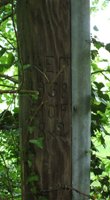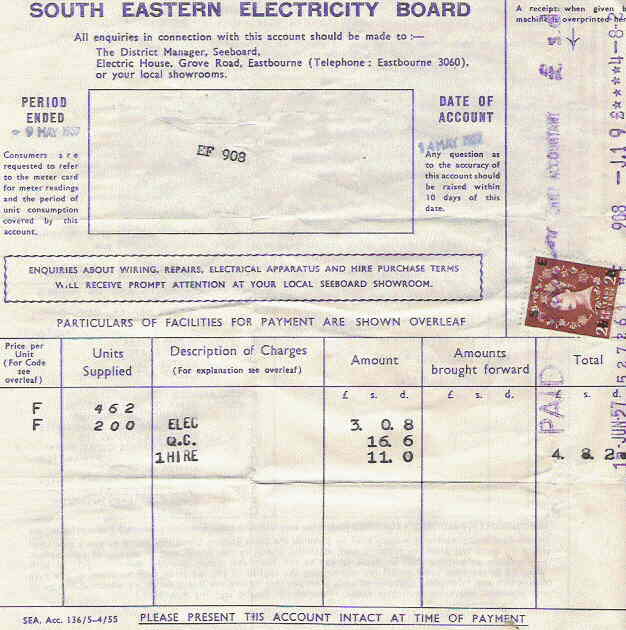| Electricity (updated 22 September 2010) |
Electricity
Supply today
The supply of electricity is quite complex
today, as the industry is fragmented into a large number of
producers and retailers. Householders locally have a large
number of would be suppliers of electricity, and prices can
be compared at impartial websites like www.uswitch.com.
In 2003 Britain's power stations produced about 380 Gigawatt hours of electricity (33% coal, 28% gas, 20% nuclear, 19% other). To reduce losses in transmission, transformers are used to step up the generated power to around 400,000 volts for the main overhead lines. It is then successively stepped down by a series of transformers and substations, ending with the small stations in most streets, that step the current down to the 240 volts we use in the home.
Nearby power stations are at:
E.On UK
RWE Npower Plc
South East London Combined Heat and Power Ltd
History
While Dartford
Urban District Council had built a power station in Priory Road
for the town in 1901, it was not for many years yet before mains
electricity would reach the wilds of Hartley. That is
not to say that everyone did not have electricity, those who
could afford it would have their own dynamo electric plant.
The first houses in Hartley to get this were Hartley Manor
("wired for electricity" by 1901) and Old Downs. In
1910 Old Downs was said to have electric light and hot water radiators
throughout the house, powered by an 11 HP electric lighting
plant, dynamo and battery. The editor of the parish magazine,
John Wells-Thatcher, put his "lion engine, dynamo, switchboard
and 14 full size Hart accumulators" up for sale in June
1932 - clearly mains electricity is much more convenient! Many
more even if they didn't have electric light, would require
a battery for their wireless set.

An
advert from the Parish Magazine in 1928 for charging radio batteries.
The first attempt to bring electricity to Hartley came in 1925 when the Gravesend Municipal Electric Company sought powers to extend its area to include Hartley and Longfield, and Fawkham, but not Ash [London Gazette 2 June 1925]. Hartley, Longfield and elsewhere were part of the areas allocated to the West Kent Electric Company by the West Kent Electric Power Act 1909, who objected to the proposed extension on those grounds. A public enquiry was held at Gravesend Town Hall on 23 April 1926. It appeared by then that Gravesend and Dartford councils had come to an agreement to allow Stone parish to be supplied from Dartford, if they supported the Gravesend application for the rest of the country area. Counsel for Gravesend and Dartford councils said that the West Kent Electric Company Limited had done nothing to bring electricity to the area in the previous 20 years, and had only laid mains when threatened now. Gravesend offered customers more flexibility in the tariff they paid. However when questioned by counsel for Dartford Rural District Council as to how soon our area would receive electricity, the Town Clerk of Gravesend said up to 10 years. This led Dartford RDC to request that the order not be passed unless Gravesend could show something would be done in our area. The representative of West Kent Electric Co, said they now supply the Thameside cement works from Barking, and had laid mains and built substations in Cobham and Meopham. In all they had spent £½ million. He said Gravesend's claim that this had been done to thwart their application was "preposterous" and "suggested megalomania". The General Manager of the County of London Electric Company, who were the parent company of West Kent, said the claims of WKEC doing nothing to bring electricity here was based on old information, before his company took over, and that they were "actively pursuing a policy to give a supply, and were in a position to do so". [Gravesend Reporter 24 April 1926].
The objections of the West Kent Electric Company prevailed [Hansard 30 July 1930].
Click here for a history of the West Kent Electric Company.
The parish requested mains electricity in 1927 and it finally arrived on 18th August 1932, when the first substation near the junction of Ash Road and Fairby Lane was switched on. The Dartford Chronicle noted wistfully that "there was no ceremony to usher in the transition from the Middle Ages to modernity". The Chronicle also reported the arrival of electricity in Longfield on 4 September 1931. Ash, Hodsoll Street and Fawkham had to wait until 1936 to be wired up. South Ash a year later.
Originally the West Kent Electric Company had wanted to bring their cables overland from Pennis House in Fawkham, but couldn't get landowner permission, so it had to be brought by underground cable from Longfield. The company would connect up to 50 feet overground or 30 feet underground for free from the road to a house, but then charged 2/6 per yard overground and 9/- per yard underground (PRO POWE 12/371). Even then there were many parts of Hartley, who had to wait for many years more to get electricity, for example electricity had still not reached the south end of Church Road in 1936, however the date on one of the poles in Grange Lane is 1938. We can get some idea of the extent people had taken up mains electricity from the National Farm Survey in 1942. At that time the following farm holdings had electricity for light or light and power (mostly for domestic use):
Many farms did not have electricity then, most notably Hartley Bottom Farm. Cabling was extended from Church Road to the Websters Chemical Works in Hartley Bottom Road in 1942.
 Electricity comes to Grange Lane in 1938 from the date on this pole (Click
on graphic for larger image)
Electricity comes to Grange Lane in 1938 from the date on this pole (Click
on graphic for larger image)
However the whole area then was underpowered, something which was to hamper the new pumping station in the 1940s. It also appears that the voltage was not increased to the 240 we know today until 1963.
In those days there was a myriad of small electricity companies (see plan of companies in 1944). Hartley, Longfield and Ash were at the eastern edge of the West Kent area, but the western end was only West Wickham near Bromley. In addition the larger towns such as Dartford and Gravesend had their own municipal electric companies. All this changed on 1 January 1948 when the Government set up the Central Electricity Generating Board and 12 area distribution boards, ours being SEEBOARD.
Charges
Never a popular
subject, and almost as soon as electricity arrived, people in
Hartley were asking for the price to be reduced (1938)!
Pictured is a Seeboard Bill for a property in Eastbourne in 1957 (then someone had to handwrite out the address of the customer! Computer billing did not reach Kent until 1969). This customer paid 1.1d per KWh on the Domestic Tariff, plus a Quarterly standing charge of 16s 6d, and 11s a quarter to rent a cooker (1 Hire)
Seeboard inherited a variety of charing regimes in 1948, but by the early 1950s the domestic tariff had been standardised at 1d per unit. This had risen to 1.1d in 1955, 1.2d (1957), 1.25d (1960), 1.5d (1962), 1.7d (1965).
In 1976 the charge was 2.525p per kilowatt hour for day units and 1.205p per KWh for night units.
In 2003 the day unit cost for Seeboard customers was 6.7 - 10.1p per unit, and 2.7p for night unit.
Today (Apr 2006) electricity varies from about 8-17p per day unit (depending on usage) and 3.5 - 4p per night unit for Economy 7 customers. Of course electricity now attracts VAT, which it didn't in 1976.
Further reading
Seeboard - the
first 25 years (by Sydney Robinson, Seeboard 1974)